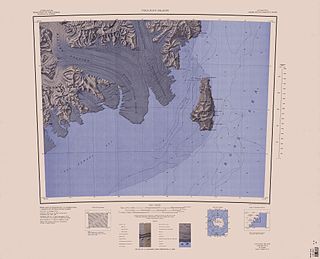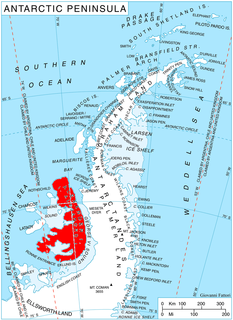
Palmer Land is the portion of the Antarctic Peninsula, Antarctica that lies south of a line joining Cape Jeremy and Cape Agassiz. This application of Palmer Land is consistent with the 1964 agreement between US-ACAN and UK-APC, in which the name Antarctic Peninsula was approved for the major peninsula of Antarctica, and the names Graham Land and Palmer Land for the northern and southern portions, respectively. The line dividing them is roughly 69 degrees south.

The Usarp Mountains is a major Antarctic mountain range, lying westward of the Rennick Glacier and trending N-S for about 190 kilometres (118 mi). The feature is bounded to the north by Pryor Glacier and the Wilson Hills. Its important constituent parts include Welcome Mountain, Mount Van der Hoeven, Mount Weihaupt, Mount Stuart, Mount Lorius, Smith Bench, Mount Roberts, Pomerantz Tableland, Daniels Range, Emlen Peaks, Helliwell Hills and Morozumi Range.

Borchgrevink Glacier is a large glacier in the Victory Mountains, Victoria Land, draining south between Malta Plateau and Daniell Peninsula, and thence projecting into Glacier Strait, Ross Sea, as a floating glacier tongue, the Borchgrevink Glacier Tongue, just south of Cape Jones. It was named by the New Zealand Geological Survey Antarctic Expedition, 1957–58, for Carsten Borchgrevink, leader of the British Antarctic Expedition, 1898–1900. Borchgrevink visited the area in February 1900 and first observed the seaward portion of the glacier.
Uranus Glacier is a glacier on the east coast of Alexander Island, Antarctica, 30 kilometres long and 10 km (6 mi) wide at its mouth, flowing east into George VI Sound immediately south of Fossil Bluff. Along the south face of the glacier is an east–west escarpment called Kuiper Scarp.

Gilbert Glacier is a glacier about 20 nautical miles (37 km) long flowing south from Nichols Snowfield into Mozart Ice Piedmont, situated in northern Alexander Island, Antarctica.

Iliev Glacier is the 5 km long and 1.5 km wide glacier located within the Lassus Mountains, situated in the northern portion of Alexander Island, Antarctica. It drains the northwest slopes of Mount Wilbye, the east slopes of Vittoria Buttress and the west slopes of Galerius Peak to flow into Lazarev Bay just south of the terminus of Palestrina Glacier.

Yozola Glacier is the 5 km long and 1.7 km wide glacier in the Sofia University Mountains situated in the northern portion of Alexander Island in Antarctica, and draining north-northwestwards between Mount Braun and Balan Ridge to flow into Palestrina Glacier.
Willey Glacier is a heavily crevassed glacier north of Creswick Peaks in Palmer Land, flowing west from Creswick Gap into George VI Sound. Named by United Kingdom Antarctic Place-Names Committee (UK-APC) for Lawrence E. Willey, British Antarctic Survey (BAS) geologist at Fossil Bluff and Stonington Island stations, 1966–69 and 1973, and awarded the Polar Medal for services to Antarctic Survey in 1976.

Wubbold Glacier is a steeply inclined glacier, 8 nautical miles (15 km) long, flowing south from the Havre Mountains, situated in the northern portion of Alexander Island, Antarctica. The glacier drains the north, west and southwest slopes of Mount Pontida, and flows into Lazarev Bay north of Mount Holt. It was photographed from the air by Ronne Antarctic Research Expedition in 1947 and was mapped from the photographs by Falkland Islands Dependencies Survey in 1960. Named by Advisory Committee on Antarctic Names for Commander J.H. Wubbold, USCG, Commanding Officer, USCGC Northwind, U.S. Navy Operation Deepfreeze, 1977.

Apollo Glacier is a glacier, 9 nautical miles (17 km) long, flowing northeast and joining the lower part of Aphrodite Glacier 2 nautical miles (4 km) from the east coast of the Antarctic Peninsula. The lower part of this glacier was first plotted by W.L.G. Joerg, from aerial photographs taken by Sir Hubert Wilkins in December 1928 and by Lincoln Ellsworth in November 1935. The glacier was subsequently photographed by the Ronne Antarctic Research Expedition in December 1947 and roughly surveyed by the Falkland Islands Dependencies Survey in November 1960. It was named by the UK Antarctic Place-Names Committee after Apollo, the god of manly youth and beauty in Greek mythology.
Vivaldi Glacier is a glacier lying between the Colbert Mountains and the Lully Foothills, flowing south from Purcell Snowfield into the head of Schubert Inlet on the west coast of Alexander Island, Antarctica. The feature appears to be first shown on maps of the United States Antarctic Service (USAS) which photographed Alexander Island from the air in 1940. It was mapped from air photos obtained by the Ronne Antarctic Research Expedition in 1947–48, by Searle of the Falkland Islands Dependencies Survey in 1960. Named "Vivaldi Gap" by the United Kingdom Antarctic Place-Names Committee in 1961, after Antonio Vivaldi (1678–1741), Venetian composer. The name was amended to Vivaldi Glacier following review of Landsat program imagery, 1979, displaying flow lines in the feature.

Foreman Glacier is a glacier flowing south-southeast from the Havre Mountains in the northern portion of Alexander Island, Antarctica. It drains the southwest slopes of Dimitrova Peak and the west slopes of Breze Peak and flows into Palestrina Glacier north of Balan Ridge in Sofia University Mountains. The glacier was surveyed by the British Antarctic Survey (BAS), 1975–76, and was named by the UK Antarctic Place-Names Committee in 1980 after David Alexander Foreman, a BAS aircraft mechanic at Adelaide Station, 1973–76.

Moran Glacier is a glacier 10 nautical miles (18 km) long, joined at the south side by Walter Glacier, flowing east into Schokalsky Bay, situated in the northeast portion of Alexander Island, Antarctica. Photographed from the air by Ronne Antarctic Research Expedition (RARE), 1947–48, and surveyed by Falkland Islands Dependencies Survey (FIDS), 1948-50. Named by Advisory Committee on Antarctic Names (US-ACAN) for Commander Clifford D. Moran, U.S. Navy, aircraft pilot, Squadron VXE-6, U.S. Navy Operation Deep Freeze, 1966 and 1977.
Himalia Ridge is a ridge running east–west on the north side of the Ganymede Heights massif, north-east of Jupiter Glacier, in the east of Alexander Island, Antarctica. It was photographed from the air by the Ronne Antarctic Research Expedition in 1947 and mapped from these photographs by D. Searle of the Falkland Islands Dependencies Survey in 1960. The ridge was named by the UK Antarctic Place-Names Committee following British Antarctic Survey geological work, 1983–84, after Himalia, a satellite of the planet Jupiter, in association with Jupiter Glacier. The site lies within Antarctic Specially Protected Area (ASPA) No.147.
Hushen Glacier is a glacier lying at the southwestern part of the base of the Mendelssohn Inlet, an inlet lying between Derocher Peninsula and Eroica Peninsula indenting the north face of Beethoven Peninsula, in the southwestern portion of Alexander Island, Antarctica. The glacier flows northeast while joining Reuning Glacier which discharges into the south part of Mendelssohn Inlet. It was mapped by the United States Geological Survey from U.S. Navy aerial photographs taken 1967–68 and from Landsat imagery taken 1972–73, and was named by the Advisory Committee on Antarctic Names for W. Timothy Hushen, Director of the Polar Research Board at the National Academy of Sciences, 1981–88.

Skarsbrotet Glacier is a cirque-type glacier draining the east slopes of Skarshaugane Peaks, in the Humboldt Mountains of Queen Maud Land. Discovered and photographed by the German Antarctic Expedition, 1938-39. Mapped by Norway from air photos and surveys by the Norwegian Antarctic Expedition, 1956–60, and named Skarsbrotet.
Holoviak Glacier is a glacier flowing west into the head of Mendelssohn Inlet, facing towards the Wilkins Ice Shelf on the north side of the Beethoven Peninsula, lying in the southwestern portion of Alexander Island, Antarctica. It was mapped by the United States Geological Survey from U.S. Navy aerial photographs taken 1967–68 and from Landsat imagery taken 1972–73, and was named by the Advisory Committee on Antarctic Names for Judy C. Holoviak, technical editor, 1964–77, of the Antarctic Research Series, published by the American Geophysical Union, and director of publications for the Union from 1978.
Reuning Glacier is a glacier situated on the north side of Beethoven Peninsula, lying within the southwest portion of Alexander Island, Antarctica. The glacier flows in a northwest direction and joins Hushen Glacier in discharging into south Mendelssohn Inlet. The glacier was first mapped by the United States Geological Survey (USGS) from U.S. Navy aerial photographs taken 1967-68 and U.S. Landsat imagery taken 1972-73. Named by Advisory Committee on Antarctic Names (US-ACAN) for Winifred M. Reuning, Office of Polar Programs, National Science Foundation (NSF), Editor, Antarctic Journal of the United States, from 1980.

Alyabiev Glacier is a glacier in Antarctica, flowing south from Gluck Peak into Boccherini Inlet and lies about 3 miles (5 km) West of Arensky Glacier on Beethoven Peninsula, Alexander Island, It was named by the USSR Academy of Sciences, in 1987, after Alexander Alyabiev (1787-1851), the Russian composer.









